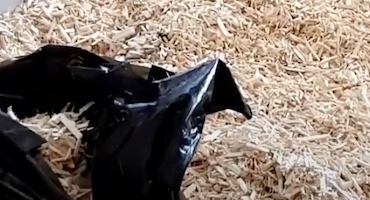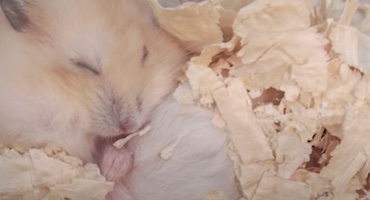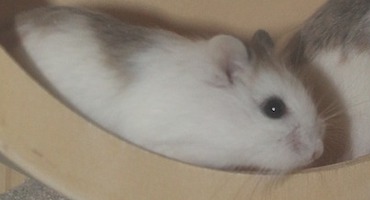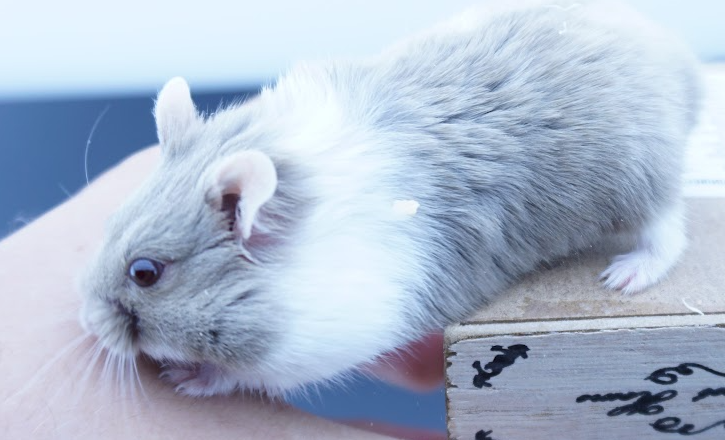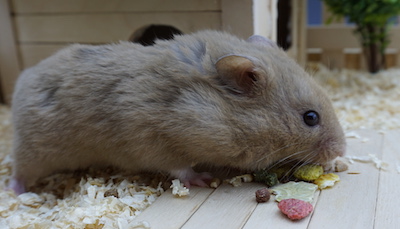The Campbell Dwarf hamster is named after a man named Charles William Campbell. He was the first Westerner to capture one of these cute rodents in 1904. Campbell’s Dwarf hamsters are found in the wild in eastern and central Asia.
In the wild, this breed of hamster creates intricate burrows that can extend up to three feet underground. These rodents line the tunnel with wool and grass they collect. They often hide down in their burrow from their predators such as owls, falcons, and foxes.
If you decide you want a Campbell Dward hamster for your new rodent companion, you will need to purchase one from a breeder. Most pet stores do not carry this breed of a hamster.
The Campbell Dwarf variety is often mistaken for its cousin the Winter White Dwarf hamster. Many pet stores will carry a hybrid variety of these two different breeds.
When you select your Campbell Dwarf hamster, you want to choose a young pet as their lifespan is rather short. Choosing a younger hamster will also ensure you can house the new friend with other same-gender Campbell Dwarfs.
Be sure to check that your new pet has bright eyes and a shiny fur coat. These are signs of health in your future pet. You can also observe the new rodent to make sure it is highly active.
Campbell Dwarf Hamster Appearance
The scientific name for the Campbell Dwarf hamster is Phodopus campbelli. These small rodents grow to the size of two inches. With the weight of less than one ounce, these dwarf hamsters are very light to handle.
Colors can range for Campbell Dwarf hamsters fur. Most of these rodents have a gray-brown coat with a darker colored stripe on their back. The stomach of your hamster will be a light gray.
Campbell Dwarf hamsters have fur covering their small feet. You will also find a variety of colors as a result of selective breeding techniques.
Care for your Cambell Dwarf Hamster
Classified as an intermediate pet, the Campbell Dwarf hamster may be more difficult to tame than other hamster species. Although they are known to bite when they feel threatened, these tiny friends can still make great pets.
Young children may have a difficult time handling the Cambell Dwarfs. These little critters are very quick and can easily slip from a small grasp. This breed of hamsters is nocturnal spending most of their active hours in the night.
Campbell Dwarf hamsters are more social than Syrian hamsters. You can house these hamsters with same-sex partners. It is wise to house these hamsters together from an early age.
Although you can put Campbell Dwarfs with same-gender peers or siblings, fighting can occur. If you see your new pets fighting, be sure to remove them immediately. It may be necessary to place them in separate houses.
If you choose to bring a Campbell Dwarf into your home, it is essential to follow some guidelines before picking up your new pet. Be patient and consistent when trying to tame your new pet.
Resist the desire to hold your hamster the first day you bring it home. Give the new pet a couple of days to adjust to its new surroundings.
Begin to talk to your Campbell Dwarf after a few days in a gentle voice. You can begin to reach your hand in the cage to change the water or replace the food. You want the hamster to get used to your hand and voice.
By now, your new pet will be familiar with your presence. Begin to put your hand in the cage until the hamster approaches and sniffs your hand. You can place a piece of seed in your palm and allow the hamster to crawl up on your hand.
If your Campbell Dwarf does nip your hand or finger, don’t panic! Slowly move your hand out of the cage and try again later. You want to be sure not to make sudden movements that will startle the hamster.
Once the new pet feels comfortable enough to approach your hand, gently raise it a few inches in the cage. It is okay if your new friend jumps off of your hand. Simply allow it to jump off and try again.
When the hamster allows you to raise your hand within the cage, you can now begin to pick it up. Start with a surface below you in case the new friend escapes your grasp. Gently cup the hamster in the palm of your hand.
Feeding Your Campbell Dwarf Hamster
In the wild, Campbell Dwarfs forage for food at night. They often travel up to a mile in search of a good meal.
With a unique feature of expandable cheeks, Cambell Dwarfs can carry foraged food and materials back to their burrow. These rodents can burrow up to three feet deep.
As a pet, you will want to feed your new Campbell Dwarf hamster a variety of seeds, nuts, and vegetables. Most pet stores carry bagged hamster food that your new pet will enjoy.
Vegetables, fruits, and the occasional insect can be given to your new hamster as a treat once or twice a week. Some good choices to provide your hamster would be carrots, cabbage or apples.
There are some treat foods that you should avoid with your pet Campbell Dwarf. You should not provide them with onion, celery, tomato, or garlic. Be sure always to wash any produce you put in the cage as well.
It is essential that your pet Campbell Dwarf has plenty of fresh water to drink. You may choose to place a sizeable ceramic water dish in their cage. Pet stores also sell plastic water bottles that attach to the side of your new pet’s cage.
If you want to know if your new hamster is getting the proper nutrition, you can observe their droppings. Loose droppings are a sign that your Campbell Dwarf may be eating too many fruits and vegetables. Very hard droppings may show you that you can feed your pet more fruits and vegetables.
Housing Your Campbell Dwarf Hamster
You can choose from a variety of cages to house your new pet. The bars of a metal cage are often too far apart to keep your hamster safely inside. Your best bet is to purchase an aquarium or plastic cage with a ventilated lid.
The Campbell Dwarf may be small in size, but your new pet needs plenty of room to run and play. At a local pet store, you can find ceramic huts that make great sleeping areas for your little friend.
To keep your new hamster comfortable, you want to line the bottom of the cage with wood shavings or shredded paper. Your Campbell Dwarf will also enjoy climbing through plastic or cardboard tubes.
Campbell Dwarf hamsters need to chew to keep their teeth healthy. You should provide them with ample wooden toys to chew on within their cage. These toys will help to keep your new pet entertained and maintain healthy teeth.
Exercise is necessary for your new pet. Hamsters love to run and play. One great toy you can provide your Campbell Dwarf is a running wheel. This wheel will be an excellent way for your rodent to stay fit.
Pet stores sell various wooden and ceramic toys to help keep your new hamster occupied. One great option for your pet is a wooden bridge. This toy will last several months and provides exercise as well as a space to gnaw.
Some Campbell Dwarf hamster owners like to place a ceramic bowl filled with sand inside of the cage. They call this a “sand bath,” which provides a place for your little pet to clean themselves.
It is likely that your new pet will begin to use this bath as a place to go “potty.” If that does happen, it makes it even easier to keep your hamster’s cage clean.
Health Concerns for Your Campbell Dwarf Hamster
When giving your new pet treats, be careful not to provide too much fresh or dried fruit. Campbell Dwarf hamsters are susceptible to diabetes. If you catch the problem early, you will be able to help prevent it from becoming severe.
Signs that your new Campbell Dwarf pet may have diabetes include excessive drinking or urination, poor fur condition, or low energy. You may also notice your new pet shivering or showing other negative behaviors.
Another common illness that you may experience with your new pet is “wet tail.” This condition is a hamster case of diarrhea. You will be able to tell that your rodent friend is experiencing this condition when they display a hunched appearance and have wet fur under their tail.
If you see the symptoms of wet tail in your new Campbell Dwarf, you should bring your pet to a veterinarian for care. The vet will be able to prescribe medication to help your new pet recover quickly.
Campbell Dwarf hamsters may develop tumors. If this happens to your new pet, a veterinarian will be able to remove this tumor and restore your hamster to health.
Keen eyesight is not one of Campbell Dwarf’s best qualities. To compensate for this poor eyesight, your pet has a powerful sense of smell. They have scent glands in various parts of their face, their cheek pouch, as well as near their rectum.
Campbell Dwarf Hamster Breeding
Your female Campbell Dwarf hamster will reach sexual maturity around four weeks of age. However, it is wise to wait until she is at least three months old before you breed her for the first time.
You want to be sure that the female Campbell Dwarf is in heat when you attempt to breed your hamster. This state happens for her every four days.
When the female is in heat, you can introduce the male into a neutral space. This space can be an enclosure you set up separate from each cage. You should place some bedding in this space.
Once you introduce the male hamster, your female Campbell Dwarf will freeze up. During that time, the male hamster will mount her several times. This process can take 20 minutes to an hour or more.
The pregnancy will typically last between 18 and 23 days for your hamster. Since your rodent is round in stature, it may be hard to notice if the female is pregnant at first. You may see other signs such as excessive drinking, or she may begin to rearrange the items in the cage.
If you decide that your Campbell Dwarf is indeed pregnant, you want to give her cage a deep cleaning and replace all the bedding. You will not want to disturb the environment once the pups are born for two weeks.
A typical litter for a Campbell Dwarf female can range from four to nine pups. When the pups are born, they will not have any fur and closed eyes. Although they cannot hear or see, they already have a keen sense of smell.
It is tempting to pick up the newborn pups because they are adorable. You should wait until the babies are two to three weeks old before attempting to handle them. They should have fur and opened eyes by this time.
Once the pups have reached three weeks, you should move each pup into a separate cage. Be sure to only house same-gender Campbell Dwarfs together to prevent any aggressive fighting.
Overall, Campbell Dwarf hamsters are a suitable choice for many pet owners. They may be more challenging to handle and tame than other breeds of hamsters. Don’t forget to take the time to tame your new pet.
After bringing your Campbell Dwarf home, enjoy this time of bonding and settling. Watching your new rodent burrow within its cage will make all the hard work of taming worth it!
Share
Related Posts
The Roborovski hamster is the smallest breed of hamster. These hamsters are also called Rob or Robo hamsters. [...]
Winter White Dwarf Hamsters get their name from their amazing ability to change the color of their fur [...]
The Syrian hamster goes by many names such as golden, teddy bear and fancy hamsters. These popular pets [...]

